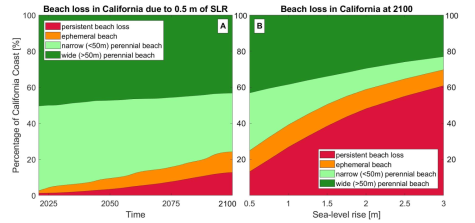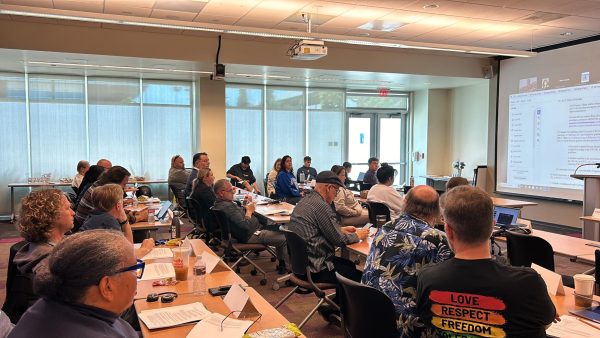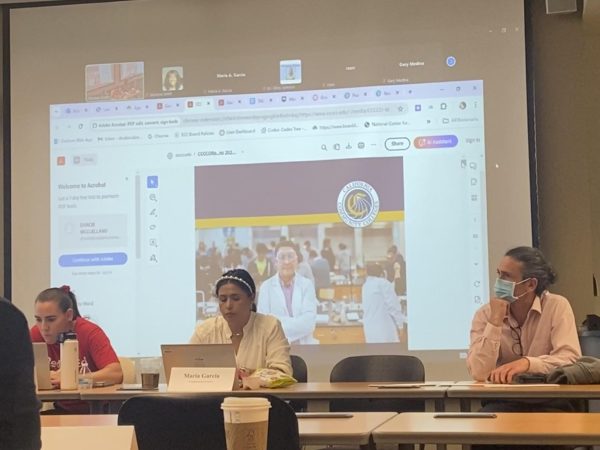Climate change amplifies California’s coastal erosion problem
Writer’s Note: This project was supported by California Humanities Emerging Journalist Fellowship Program. For more information, visit www.calhum.org.
Any views or findings expressed in this publication do not necessarily represent those of California Humanities or the National Endowment for the Humanities.
Editor’s Note: Fixed misspelled name for photo captions on June 12.
Most of California’s beaches could be washed away by 2100, according to a recent study from the United States Geological Survey.
The impact of coastal erosion, which refers to the soils, rocks and sands carried away or worn down by changes in the climate, has worsened with climate change.
Using satellite data and shoreline models, the study assesses changes in California’s coasts due to the combination of rising sea levels, rising land and natural causes such as more atmospheric rivers for the Golden State.
California’s coastline stretches 840 miles and contains over 420 different beaches.
According to the California Coastal Commission, California’s beaches get visited more than 150 million times per year, making the ocean and coasts in California one of its most popular destinations for both tourists and local residents.
What causes coastal erosion
The Monterey Bay National Marine Sanctuary found 85% of California’s coasts are experiencing active erosion from human involvement and natural causes.
The recent wave of rainstorms that hit California has also contributed to the state’s coastal erosion problem, according to an interactive topographic map showing erosion before and after atmospheric rivers hit the coasts in January.
El Camino College’s earth sciences professor Sara Di Fiori said human interaction and misuse can contribute to the problem as well.
“All of these impacts and all of these collisions between the ocean, gravity, time and weather are constantly shaping the coast,” Di Fiori said. “If there weren’t people (living) there, this wouldn’t be a problem.”
The South Bay coast, a region in southwest LA County, experienced increased erosion due to the wave of heavy rainstorms.
Rancho Palos Verdes, a city on the Palos Verdes Peninsula, is in a unique position as it sits directly above a fault line that worsens its coastal erosion problem.
“There’s a fault that is lifting (Palos Verdes Peninsula) out of the ocean. It goes up, sometimes the fault’s not active and it erodes and gets smaller,” Di Fiori said.
Di Fiori said rising sea levels and rain storms also increase the “energy” that shapes its coastlines.
The U.S. Geological Survey’s study on coastal erosion simulates what the state of coastal erosion in California may look like throughout the century.

Both figures show beach loss will stay roughly the same through 2025 and 2030. It isn’t until the mid to late 2030s beach loss will become more prevalent and increase year by year.
After 2050, the amount of beach loss over time sees a rapid and persistent increase with permanent beach loss due to sea levels rising from 0.5 to 3 meters in total.
The potential solutions
With the constant loss of soil, rocks and sands, one of many methods to help mitigate the damage and improve the structure of California’s coasts is through beach nourishment — a temporary solution that involves refilling the lost sand to widen the beaches and coasts.
Another method is called the “Living Shoreline,” Which reduces costs to an underdeveloped state to then be built upon with natural structural and organic resources.
Associate Planner for Rancho Palos Verdes Steven Giang said the coastal erosion plan for the Palos Verdes Peninsula involves a preventative measure that minimizes development with zoning.
“We have stricter standards when you’re along the coasts and that gradually gets less strict as you go away from it,” Giang said.
The irreversible impacts of coastal erosion on California necessitate a focus on preventive measures, which can help mitigate further deterioration by implementing comprehensive planning and proactive monitoring strategies along the coasts.
Climate Central Inc., an independent group of scientists and researchers, predicts the Santa Monica Pier could be completely submerged in the ocean within 80 years if climate change is not addressed.
J.D. Allen, an award-winning podcast host recognized for excellence in science communication by the National Academy of Science, said neighborhoods might need to move in a “coastal retreat.”
“Your southern sunny California beaches that everybody loves are gonna be washed away … and so that economic value that California has for its pristine beaches is going to disappear,” Allen said.
Allen said coastal erosion can also worsen sewage, electricity and essential trading harbors that include access to fishing vessels and cargo ships. He noted if people want to continue living and building along the coasts, they have to adapt.
“A lot of my podcasting work has been about climate adaptation,” Allen said. “If we want to continue to live somewhere, we have to figure out a way.”
Editor’s Note: Set feature image on June 6.
















